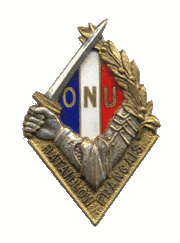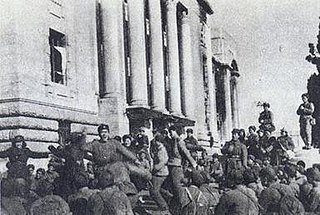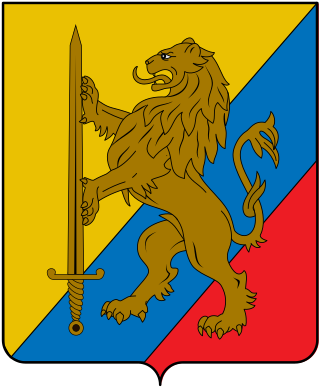This is the Korean War order of battle. Subsidiary commands are listed on sub-pages. Where no date is shown for a command, assume it present at the start of the war, on June 25, 1950.
The Presidential Unit Citation is a military unit award of the government of Republic of Korea that may be presented to South Korean and foreign military units for outstanding performance in defense of the Republic of Korea. In recognition of allied military service to South Korea during the Korean War, all United States military departments were authorized the unit award for that period.

The French Battalion of the United Nations Organisation was a battalion of volunteers made up of active and reserve French military personnel sent to the Korean Peninsula as part of the UN force fighting in the Korean War.

The 6th Infantry Division is a military formation of the Republic of Korea Army.

The 7th Infantry Division, also known as the "Seven Stars Division", is a military formation of the Republic of Korea Army, currently employed on patrol duty in the Korean Demilitarized Zone around the mountainous Hwacheon County, Gangwon Province. The division is part of the II Corps. It has a GOP(General outpost) brigade, a reserve brigade, an artillery brigade, and a subordinate force.
The 12th Infantry Division was a division of the Korean People's Army during the 20th century. Originally, it was the 156th Division, which was created in November 1948 under the Regulation of the Redesignations of All Organizations and Units of the Army, issued by Central Military Commission on November 1, 1948, basing on the 6th Independent Division, PLA Northeastern Field Army.
The 20th Group Army is a military formation of the People's Liberation Army Ground Force, stationed in the Jinan Military Region. It consists of two manoeuvre brigades with other attached or otherwise organic units. For some time after its formation in 1949, the army consisted of three divisions.

The 80th Group Army, Unit 31673, formerly the 26th Group Army, is a military formation of the Chinese People's Liberation Army Ground Forces (PLAGF). The 80th Group Army is one of thirteen total group armies of the PLAGF, the largest echelon of ground forces in the People's Republic of China, and one of three assigned to the nation's Northern Theater Command.

Australia entered the Korean War on 28 September, 1950; following the invasion of South Korea by North Korea. The war's origins began after Japan's defeat in World War II, which heralded the end to 35 years of Japanese occupation of the Korean Peninsula. The surrender of Japan to the Allied forces on 2 September 1945 led to the division of Korea into two countries, which were officially called the Democratic People's Republic of Korea (DPRK) and the Republic of Korea (ROK). The DPRK were occupied by the Soviet Union, and the ROK, below the 38th Parallel, were occupied by the United States (US).

The Battle of Unsan, also known as the Battle of Yunshan, was a series of engagements of the Korean War that took place from 25 October to 4 November 1950 near Unsan, North Pyongan province in present-day North Korea. As part of the People's Republic of China's First Phase Campaign, the People's Volunteer Army (PVA) repeatedly attacked the Republic of Korea Army's (ROK) 1st Infantry Division near Unsan beginning on 25 October, to surprise the advancing United Nations Command (UNC). The United State's (US) 8th Cavalry Regiment was encircled on 1–2 November and broke out with the loss of most of its heavy equipment.

The Battle of Onjong, also known as the Battle of Wenjing, was one of the first engagements between Chinese and South Korean forces during the Korean War. It took place around Onjong in present-day North Korea from 25 to 29 October 1950. As the main focus of the Chinese First Phase Offensive, the People's Volunteer Army (PVA) 40th Corps conducted a series of ambushes against the Republic of Korea Army (ROK) II Corps, effectively destroying the right flank of the United States Eighth Army while stopping the UN advance north toward the Yalu River.

The Battle of Wawon(Korean: 군우리 전투; hanja: 軍隅里戰鬪; rr: Gunuri Jeontu; Turkish: Kunu-ri Muharebesi), also known as the Battle of Wayuan, was a series of delay actions of the Korean War that took place from 27–29 November 1950 near Wawon in present-day North Korea. After the collapse of the US Eighth Army's right flank during the Battle of the Ch'ongch'on River, the Chinese People's Volunteer Army (PVA) 38th Corps advanced rapidly towards the critical road junction at Kunu-ri in an effort to cut off United Nations forces' retreat route. In what was considered to be Turkey's first real combat action since the aftermath of World War I, the Turkish Brigade attempted to delay the Chinese advances at Wawon. Although during the battle the Turkish Brigade was crippled after being encircled by Chinese forces with superior numbers, they were still able to breach the Chinese trap and rejoin the US 2nd Infantry Division. Delay of the PVA advance after meeting with heavy Turkish resistance helped the other United Nations forces to withdraw without suffering many casualties and reassemble later in December.

The Battle of the Ch'ongch'on River, also known as the Battle of the Ch'ongch'on, was a decisive battle in the Korean War that took place from November 25 to December 2, 1950, along the Ch'ongch'on River Valley in the northwestern part of North Korea. In response to the successful Chinese First Phase Campaign against the United Nations (UN) forces, General Douglas MacArthur launched the Home-by-Christmas Offensive to expel the Chinese forces from Korea and to end the war. Anticipating this reaction, the Chinese People's Volunteer Army (PVA) Commander Peng Dehuai planned a counteroffensive, dubbed the "Second Phase Campaign", against the advancing UN forces.

The Third Battle of Seoul was a battle of the Korean War, which took place from December 31, 1950, to January 7, 1951, around the South Korean capital of Seoul. It is also known as the Chinese New Year's Offensive, the January–Fourth Retreat or the Third Phase Campaign Western Sector.

The First and Second Battles of Wonju, also known as the Wonju Campaign or the Third Phase Campaign Eastern Sector, was a series of engagements between North Korean and United Nations (UN) forces during the Korean War. The battle took place from December 31, 1950, to January 20, 1951, around the South Korean town of Wonju. In coordination with the Chinese capture of Seoul on the western front, the North Korean Korean People's Army (KPA) attempted to capture Wonju in an effort to destabilize the UN defenses along the central and the eastern fronts.

The 81st Group Army, Unit 31675, formerly the 65th Group Army, is a military formation of the Chinese People's Liberation Army Ground Forces (PLAGF). The 81st Group Army is one of thirteen total group armies of the PLAGF, the largest echelon of ground forces in the People's Republic of China, and one of three assigned to the nation's Central Theater Command.

The 71st Group Army, Unit 31655, formerly the 12th Group Army, is a formation of the Chinese People's Liberation Army Ground Forces (PLAGF). The 71st Group Army, is one of thirteen total group armies of the PLAGF, the largest echelon of ground forces in the People's Republic of China. Assigned to the nation's Eastern Theater Command, the primary mission of the 71st Group Army is likely preparation for conflict in or about the Taiwan Strait. The unit is headquartered in Xuzhou City, Jiangsu Province.
The Canadian Forces were involved in the 1950–1953 Korean War and its aftermath. More than 30,000 Canadians participated on the side of the United Nations, and Canada sent eight destroyers. Canadian aircraft provided transport, supply and logistics. 516 Canadians died, 312 of which were from combat. After the war, Canadian troops remained for three years as military observers.

The Colombian Battalion was an infantry battalion of the Colombian Army that served under United Nations Command during the Korean War from 1951 to 1954. The first Colombian military unit to serve in Asia, the battalion was attached to the U.S. 7th Infantry Division and 25th Infantry Divisions.










